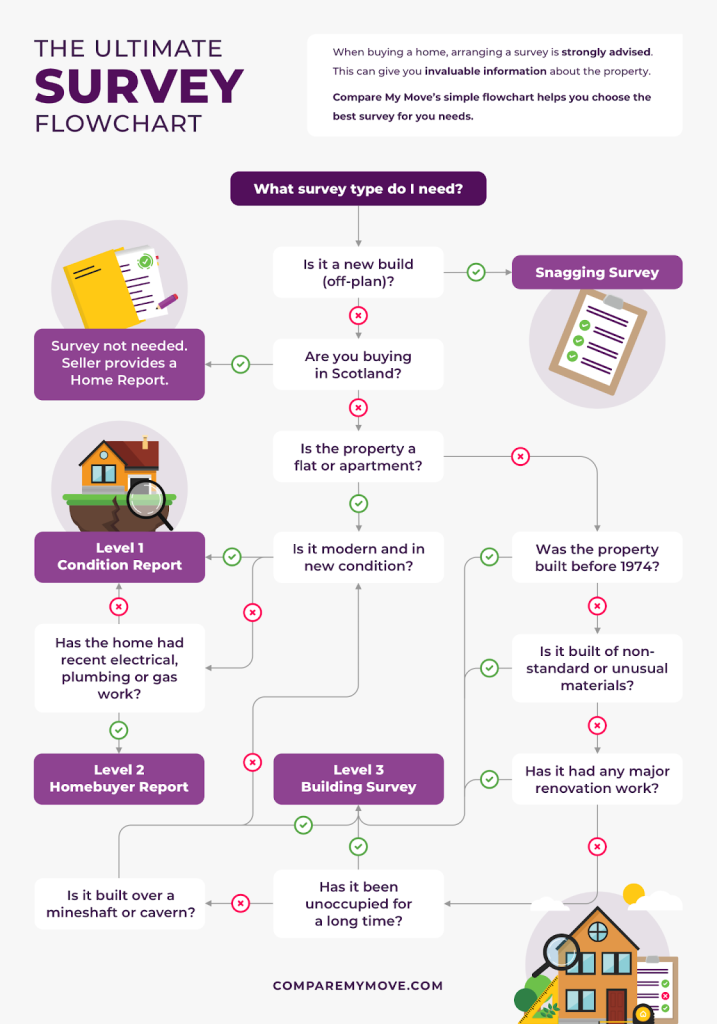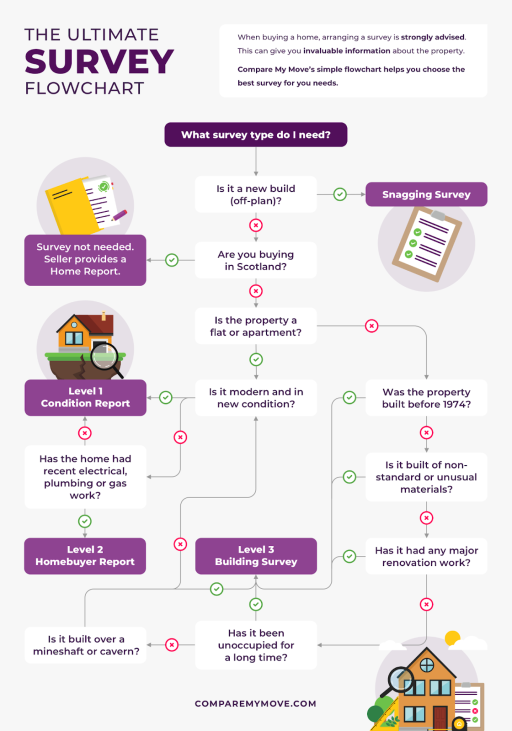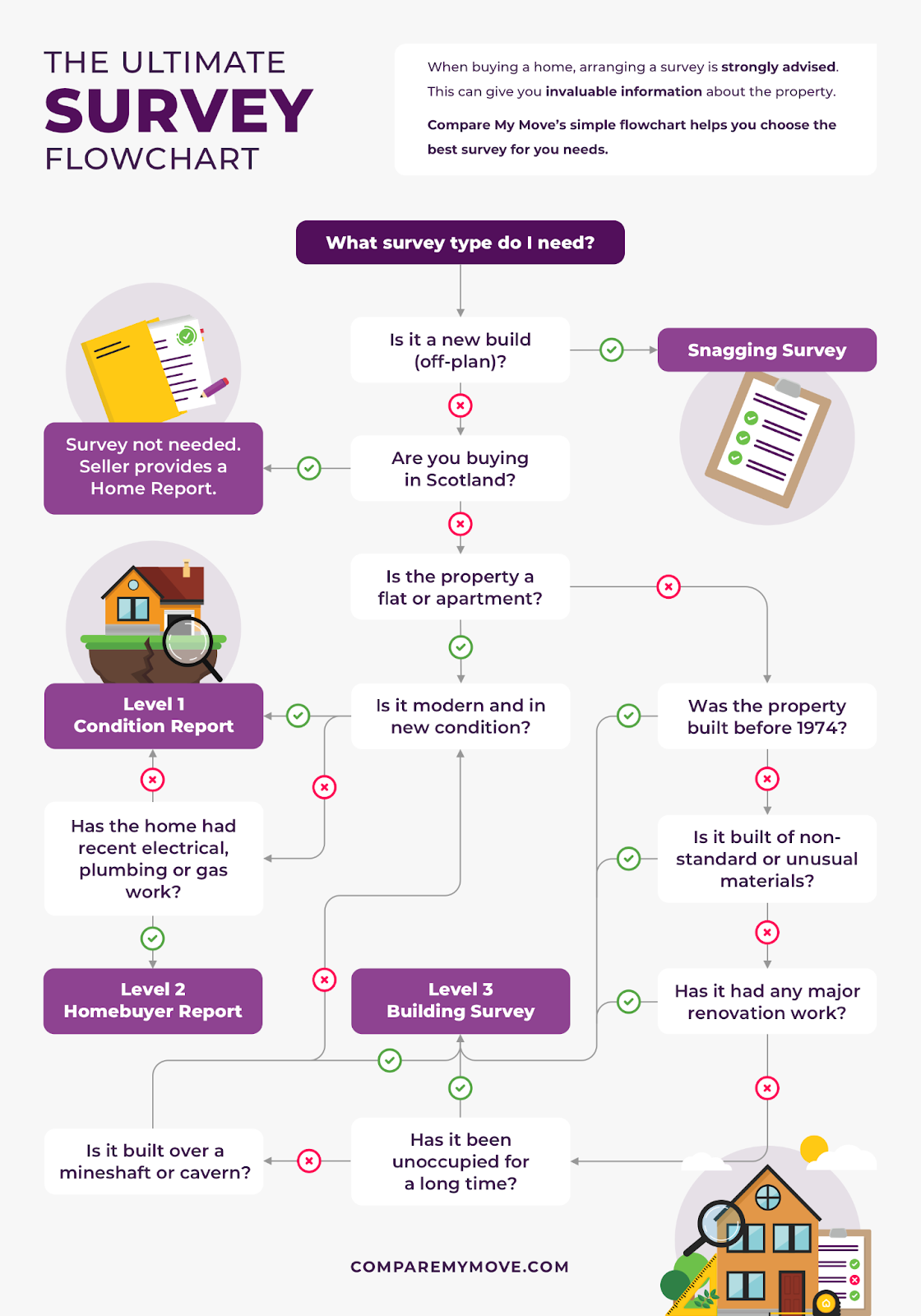The start of 2024 has brought with it a sense of stability in the housing market, with house prices on the rise and an increase in people enquiring about conveyancing solicitors and removal companies. With this stability, we are seeing a huge increase in people looking for house surveys.
Compare My Move has seen an 88.7% increase in people looking for all survey types between December of 2023 and January of 2024.
| Survey Type | Percentage Increase |
| Snagging Survey | 43.1% |
| Level 2 Homebuyer Report | 84.8% |
| Level 3 Building Survey | 101.3% |
| Total | 88.7% |
Although all survey types saw a significant increase, the Level 3 Building Survey saw the largest increase, almost doubling in enquiries at the start of 2024.
Many factors go into what survey you’ll need for your specific property, and it can be difficult to know what factors will influence the survey you need. Compare My Move’s Ultimate Survey Flowchart is designed to help you figure out what survey you need or whether you’ll need a survey at all.

Different types of surveys
There are 4 different types of surveys that you may need when buying a property, a snagging survey, a level 1 condition report, a level 2 homebuyer report, and a level 3 building survey. Each report will cover different issues that will be surveyed in different ways and at different depths.
Snagging Survey
If you’re buying a new build house, a professional snagging survey will provide you with a list of any “snags” to be passed on to the property developer before you move in.
These snags can range from small defects to major faults. Typical smaller issues include cracked tiles or loose door hinges, while larger issues could be structural problems like external brickwork.
Although you can create a new build snagging list yourself, hiring a surveyor is recommended as they’ll have more knowledge of what to look for. The surveyor will provide a thorough report with all issues listed.
Level 1 Condition Report
Previously known as Condition Report, the Level 1 Survey is the most basic and therefore cheapest RICS survey. All nearly new flats and homes will be best suited to the Level 1 Survey.
It’ll provide an overview of the property’s condition, but not in great detail. No surveyor’s opinion, advice or valuation is given, only obvious defects and the condition of the services like gas and water supply will be flagged.
Level 2 Homebuyer Report
Also referred to as a Home Buyers Survey or Home Buyer Report, the Level 2 Survey is suited for conventional properties built less than 50 years ago. It highlights any major issues with the property such as subsidence or damp and will look at defects both internally and externally.
The Level 2 Survey only looks at issues that are surface level and won’t check under floorboards or behind walls. Your surveyor will mark any major issues as a ‘3’ in the report and minor ones as ‘1’.
The report will also include an insurance reinstatement figure and a market value.
Level 3 Building Survey
Previously known as a Building Survey, a Level 3 Survey is best suited to older homes or non-standard construction houses. This could include thatched cottages, steel frame houses or PRC properties. It’ll look at the condition of the roof, the integrity and structure of the walls and the state of the floors.
Your report will detail each aspect inspected and will include any recommendations your surveyor has on repair work. If requested the report may also contain cost considerations for the elements included.
Is It Worth Getting a House Survey?
A property survey can save you £5,750 on average in repair work, research by RICS discovered. As a survey will highlight any repair work, this allows you to negotiate your original offer and the final cost of the property. This can ultimately save you thousands of pounds in repairs.
How Long Does a House Survey Take?
A Level 1 Survey will take between 2 and 4 hours as it is the most basic survey type. The Level 2 will also take 2-4 hours, but if the surveyor needs to gain access to certain areas, this can take longer. The Level 3 survey will take the longest with an average timescale of 4-8 hours, depending on condition and size.
What Survey Would I Need in Scotland?
In Scotland, it’s the seller’s responsibility to order the Home Report. It must be carried out before a sale is complete to ensure that buyers are aware of the property’s condition. The Home Report is made up of a single survey, an energy performance certificate and a property questionnaire. The single survey provided will produce reports like that of a Level 2, with similar issues and defects being recorded.







